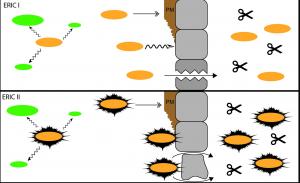Literatura
- Alippi A. M., Reynaldi F. J., Lopez A. C., De Giusti M. R., Aguilar O. M. (2004): Molecular epidemiology of Paenibacillus larvae larvae and incidence of American foulbrood in argentinean honeys from Buenos Aires province. Journal of Apicultural Research 43, 135–143.
- Antunez K., Arredondo D., Anido M., Zunino P. (2011): Metalloprotease production by Paenibacillus larvae during the infection of honeybee larvae. Microbiology-Sgm 157, 1474–1480.
- Brandt C. R., Adang M. J., Spence K. D. (1978): Peritrophic membrane - ultrastructural analysis and function as a mechanical barrier to microbial infection in orgyia-pseudotsugata. Journal of Invertebrate Pathology 32, 12–24.
- Ebeling J., Knispel H., Hertlein G., Funfhaus A., Genersch E. (2016): Biology of Paenibacillus larvae, a deadly pathogen of honey bee larvae. Applied Microbiology and Biotechnology 100, 7387–7395.
- Funfhaus A., Poppinga L., Genersch E. (2013): Identification and characterization of two novel toxins expressed by the lethal honey bee pathogen Paenibacillus larvae, the causative agent of American foulbrood. Environmental Microbiology 15, 2951–2965.
- Garcia-Gonzalez E., Poppinga L., Funfhaus A., Hertlein G., Hedtke K., Jakubowska A., Genersch E. (2014): Paenibacillus larvae chitin-degrading protein plcbp49 is a key virulence factor in American foulbrood of honey bees. Plos Pathogens 10, 12.
- Genersch E., Ashiralieva A., Fries I. (2005): Strain- and genotype-specific differences in virulence of Paenibacillus larvae subsp larvae, a bacterial pathogen causing American foulbrood disease in honeybees. Applied and Environmental Microbiology 71, 7551–7555.
- Giovannoni S. J., Annual R. 2017. Sar11 bacteria: The most abundant plankton in the oceans. Annual review of marine science, vol 9. Palo Alto: Annual Reviews.
- Hansen H., Brodsgaard C. J. (1999): American foulbrood: A review of its biology, diagnosis and control. Bee World 80, 5–23.
- Hertlein G., Seiffert M., Gensel S., Garcia-Gonzalez E., Ebeling J., Skobalj R., Kuthning A., Sussmuth R. D., Genersch E. (2016): Biological role of Paenilarvins, iturin-like lipopeptide secondary metabolites produced by the honey bee pathogen Paenibacillus larvae. Plos One 11, 14.
- Holbourn K. P., Shone C. C., Acharya K. R. (2006): A family of killer toxins - exploring the mechanism of adp-ribosylating toxins. Febs Journal 273, 4579–4593.
- Peng C. Y. S., Mussen E., Fong A., Cheng P., Wong G., Montague M. (1996): Laboratory and field studies on the effects of the antibiotic tylosin on honey bee Apis mellifera l (Hymenoptera: Apidae) development and prevention of American foulbrood disease. Journal of Invertebrate Pathology 67, 65–71.
- Poppinga L., Janesch B., Funfhaus A., Sekot G., Garcia-Gonzalez E., Hertlein G., Hedtke K., Schaffer C., Genersch E. (2012): Identification and functional analysis of the s-layer protein spla of Paenibacillus larvae, the causative agent of American foulbrood of honey bees. Plos Pathogens 8, 13.
- Ueno Y., Yoshida E., Misumi W., Watando E., Suzuki K., Hirai Y., Okura M., Osaki M., Katsuda K., Takamatsu D. (2018): Population structure and antimicrobial susceptibility of Paenibacillus larvae isolates from American foulbrood cases in Apis mellifera in Japan. Environmental Microbiology Reports 10, 210–216.
- Yue D., Nordhoff M., Wieler L. H., Genersch E. (2008): Fluorescence in situ hybridization (fish) analysis of the interactions between honeybee larvae and Paenibacillus larvae, the causative agent of American foulbrood of honeybees (Apis mellifera). Environmental Microbiology 10, 1612–1620.
